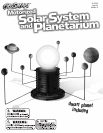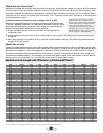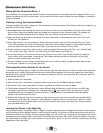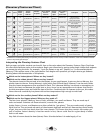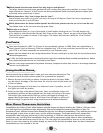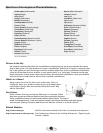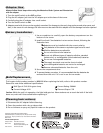
Which planets have the most moons? Are they large or small planets?
T
he larger planets have a stronger gravitational pull, so they often have many satellites, or moons. These
larger planets can “capture” or pull moons into their gravitational fields more easily because objects (such
as moons) move more slowly in space.
Which planet has a “day” that is longer than its “year”?
Venus rotates very slowly on its axis: one day is as long as 243 days on Earth! Yet Venus completes an
o
rbit around the sun in only 225 days.
Which planets have the fastest orbital speeds? Are the faster planets near the sun or far from the sun?
The planets closer to the sun move through space faster.
What else is out there?
Beyond Neptune there is a ring of thousands of small bodies orbiting the sun. This disk-shaped ring
of icy objects is called the Kuiper (KI-per) Belt. Pluto and its moon, Charon, are part of the Kuiper Belt.
There are also a number of comets in this region. The Kuiper Belt has been called the ”Final Frontier”
of our solar system.
Using the Star Dome
Fun Facts
Star Dome Classroom Activities
Pluto was discovered in 1930. For 76 years it was considered a planet. In 2006, Pluto was reclassified as a
dwarf planet. Since its discovery, Pluto has completed only 31% of one revolution around the sun. By the
year 2178, it will have completed one revolution (or one Plutonian year).
Jupiter spins the fastest on its axis. Its day lasts less than 10 hours. It also spins so fast that the round planet has a
flattened appearance.
In 1543, the Polish astronomer and priest Nicolaus Copernicus noted that Earth revolved around the sun. Before
then, people believed that the sun revolved around Earth.
The sun is very large compared to the planets. However, compared to other stars, the sun is an average-sized star.
The sun is our closest star.
Here’s a second way to explore space: create your own classroom planetarium! The
star dome converts the solar system model into a planetarium projector.
1. Remove the top half of the sun sphere. Put the star dome in its place. Make
sure the tab on the edge of the star dome fits into the notch on the lower half
of the sun sphere.
2. The projected image will look best in a darkened room. If possible, turn off
the lights and close the shades.
3. Switch on the light at the base of the tower. Stars, constellation names, and
constellation outlines will be projected onto the walls and ceiling of the room.
The farther light travels before hitting a surface, the bigger the image will
appear. Moving the tower closer to and further from the walls or ceiling will
alter the image. To get the best image, experiment with different distances.
Constellations are clusters of stars whose patterns resemble shapes and figures. Breaking the 1,000 to 1,500 stars visible
on a dark night into constellations helps people easily find and remember the names and locations of stars. For
thousands of years, different cultures have divided the night sky into different constellations. They used the stars to help
them navigate, to plan when to plant crops, and for religious purposes. The Greeks and Romans named their
constellations after the gods and heroes in their mythology. In 1929 the International Astronomical Union
divided the stars into 88 official constellations that are used by astronomers today. Most of these constellations
come from the Greek and Roman view of the sky. The next page lists constellations that are on this model’s star
dome. As your class observes this stellar display, try some of the activities provided. Note: Southern Hemisphere
constellations are not included in this list.



